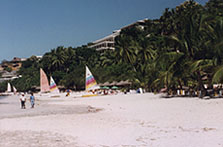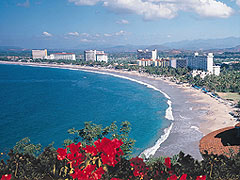- Fishing & Diving
- Local Tours
Sportfishing
Ixtapa/Zihuatanejo is just being discovered as Mexico's exciting
sportfishing destination. Anglers thrill at the profusion of sailfish, black
and blue marlin (the record is over 1,000 pounds), as well as yellowfin
tuna and dorado (mahi-mahi). The fleets are on specialized cruisers or
pangas with expert and caring bilingual skippers.

Water activities abound on Zihuatanejo Bay
Scuba Diving
Some 30 dive sites in the area range from deep canyons to shallow reefs.
The waters here are teeming with sea life and visibility is excellent. Many
opportunities exist for divers & snorkelers.
Water Sports
A variety of water sports is available in Ixtapa, along Playa del Palmar
(the beach of the Hotel Zone) and in Zihuatanejo on La Ropa Beach.
Parasailing costs about $20 for about a 10-minute ride; water skiing and
wave runners cost about $30 per half-hour; banana boat rides are about
$5 for a 20-minute trip.
On La Ropa Beach, in front of the Hotel Villa del Sol, Hobie Cats rent
for $20 per hour and classes cost $30 per half-hour. Windsurfers rent
$10 per hour; classes which include 6 hours over 4 days cost $40.
Golf
There are two 18-hole championship courses in Ixtapa. The Campo de
Golf Ixtapa designed by Robert Trent Jones Jr., is a wildlife preserve
that runs from a coconut plantation to the beach. Part of the Marina
Ixtapa complex, the highly challenging links layout Club de Golf Marina
Ixtapa was designed by Robert von Hagge. Each as its own clubhouse
with all facilities and a restaurant as well as tennis courts. Green fees run
approximately $55; caddies or carts $20. Please click on Golf below for more information.
Tennis
All major Ixtapa hotels have night-lit tennis courts as do the Campo de
Golf Ixtapa and the Club de Golf Marina Ixtapa. In Zihuatanejo, theHotel
Villa del Sol has two courts which are primarily for guest use.
Horseback Riding
You can rent horses near Playa La Ropa in Zihuatanejo, and at Playa
Linda just up the coast from Ixtapa. The beaches are excellent for
relaxing rides.
Guided Tours
Most major hotels have lobby tour desks or travel agencies which offer a
selection of sightseeing tours, land or sea, of Ixtapa, Zihuatanejo and
surrounding areas. There are many jungle, lagoon and sea tours also available and you can even ask the local taxi drivers to show you the crocodiles found in the area.
BEACHES
Zihuatanejo
Zinhuatanejo is a tropical charmer. Because the bay is naturally enclosed, the water is calm and beaches have virtually no surf. The picturesque main beach, Playa Principal or Municipal, at the edge of town, is rimmed by the Paseo del Pescador (fisherman's walk) and the municipal pier at one end. Here local fisherman keep their skiffs and gear used for nightly fishing journeys out to sea. They return here in the morning to display and sell their catch to the local market and restaurants.
Counterclockwise around the bay, Playa La Madera is walkable along a narrow, seaside footpath (called extensión del Paseo del Pescador) cut into the rocks. Also accesible by road, this pancake-flat, dark sand beach has a sprinkling of small hotels and restaurants. It was named "madera" (wood) beach because during the Spanish colonization it was an embarcadero for shipping oak, pine, cedar and mahogany cut from the nearby Sierra Madre Sur mountains.

Looking north along Playa La Ropa
On the other side of a rocky point is Playa La Ropa, the most beautiful and longest beach in the area, and only 5-minute, scenic taxi ride from town is world famous. Along this one-kilometer stretch of soft sand are water sports facilities, open-air restaurants, & a few hotels. It got its name ("clothes beach") when a Spanish galleon returning from the Orient ran aground, leaving its cargo of silks and clothing strewn all over the beach.
Continuing counterclockwise is Playa Las Gatas, the beach was named for long-gone harmless, docile nurse sharks that used to linger here("gatas", in this case, translates to "nurse sharks", not "female cats"). A mysterious long row of hewn rocks just offshore serves as a "breakwater". It can be explained only by legend: perhaps a "Calzontin" (the title for a pre-Hispanic Purepechan king) built it to shelter his royal daughter's private beach. The beach is now lined with simple seafood eateries that also have lounge chairs for sunning.
Las Gatas is accessible only by boat. Small outboard canopied skiffs (pangas) run continously from and to the municipal pier until 5 PM. The trip takes about 10 minutes. Purchase your round-trip ticket (about $2) at the Cooperativa office at the beginning of the pier. Keep the ticket stub for your return trip.
Ixtapa
Ixtapa, just up the coast (northwest), offers another variety of beaches. The first is Playa Vista Hermosa, a small cove which is actually the beach of the Westin Brisas. Ixtapa's main beach is Playa del Palmar, a 2-mile long, broad sandy stretch which is the location of the "Hotel Zone", a row of the resort's major 4- and 5-star beachfront hotels ending at the Marina Ixtapa.

Looking north along Playa del Palmar
Water sports facilities are available along the beach. Since this is essentially open sea, there is surf which at times can be quite strong. Most hotels will have a warning system, by flag color with explanation, at their beach entrance.
About ten minutes beyond the Ixtapa Hotel Zone is the long, pristine Playa Linda. At the edge of the beach is a handicraft mart, as well as a rock jetty from which covered skiffs (pangas) take passengers on a 10-minute ride to Ixtapa Island (they used to leave from nearby Playa Quieta until the beach was taken over at the end of 1995 by Club Med). The boats run continously (on demand) from early morning until 5 p.m. A round trip costs about $2-$3 (keep ticket stub to return). You can also go horseback riding here or view the crocodiles at this local reserve.
The Isla Ixtapa's most popular beach is Playa Cuachalalate named for an endemic tree whose bark has been used since ancient times as a remedy for kidney ailments. Like Las Gatas in Zihuatanejo, this beach is also lined with good seafood eateries.
At the north end of the beach, watersport rental equipment, instruction and dive excursions are available. A short walk across to the other side of the island takes you to a gorgeous, sandy beach called Playa Varadero, which faces the sunset. It is also lined with small restaurants, and there are water sports facilities. Just behind the restaurants is Playa Coral with crystal-clear water great for snorkeling. A fourth beach, Playa Carey, toward the south end of the island, is small and isolated. The pangas run between the small boat landings at both Cuachalalate and Varadero beaches and Playa Linda on the mainland. Make sure you don't miss that last run to the mainland or you might find yourself paying much more to get back, or actually sleeping over on the beach!
SIDE TRIPS
Barra de Potosí
For those wanting to roam, head south about 19 kms. to this small, idyllic seaside fishing settlement. Barra is at the beginning of a lovely 16-km.-long stretch of beach known as Playa Blanca. The attractions here include great ocean swimming, several tasty and economical palapa restaurants (called enramadas), and an enormous lagoon with excellent bird and wildlife watching (boat tours are available & cost around 50 pesos). Adding to the mystic is the local legend of pirate treasure buried just south of the village's restaurant row. Gold coins have been found....
La Soledad de Maciel
To the south of Barra de Potosí is the town of Petatlán where you'll find one of Guerrero's precolumbian treasures, La Soledad de Maciel. The area is sometimes called "La Choli". Although the site is very small and not on the grandeur of most archaeological sites in Mexico, La Soledad appears to have been an important ceremonial site of Cihuatlán, the capital of an indigenous city-state. Here you will find odd rock formations, rock art and even the remains of a ball court. There is a big stone idol called "El Rey" which the site is probably most famous.
Most visitors won't seek the area out, but if you are an amateur archaeologist and are not disappointed easily, you will enjoy the area. You will probably need a guide (see Land Activities) who is knowledgeable and speak English. Once there, the locals (mainly children) will try to sell you artifacts similar to the ones in the Museo Arqueol�gico in Zihuatanejo. They may or may not be authentic.
Petatlán also has the Santuario al Padre Jesús, reconstructed church which is famous for the gold vendors on weekends. You'll also find nearby beaches and lagoons.
Troncones Beach
To the north of of Ixtapa approximately 35 kms. you'll find another idyllic spot called Troncones Beach. Click on the Troncones Beach Guide for information and lodging, restaurants and how to get there.
|